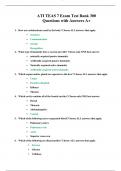Exam (elaborations)
ATI TEAS 7 Exam Test Bank 300 Questions with Answers A+ Latest
- Course
- Institution
ATI TEAS 7 Exam Test Bank 300 Questions with Answers A+ Latest l ATI TEAS 7 Exam Test Bank 300 Questions with Answers A+ 1. How are carbohydrates used by the body? Choose ALL answers that apply. • structure • Communication • storage • Recognition 2. What type of immunity does a v...
[Show more]



